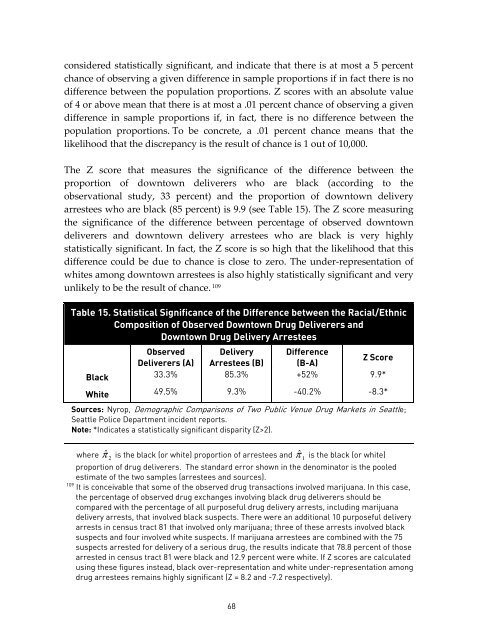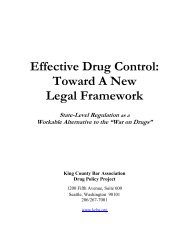RACE AND THE ENFORCEMENT OF DRUG DELIVERY LAWS IN ...
RACE AND THE ENFORCEMENT OF DRUG DELIVERY LAWS IN ...
RACE AND THE ENFORCEMENT OF DRUG DELIVERY LAWS IN ...
Create successful ePaper yourself
Turn your PDF publications into a flip-book with our unique Google optimized e-Paper software.
considered statistically significant, and indicate that there is at most a 5 percent<br />
chance of observing a given difference in sample proportions if in fact there is no<br />
difference between the population proportions. Z scores with an absolute value<br />
of 4 or above mean that there is at most a .01 percent chance of observing a given<br />
difference in sample proportions if, in fact, there is no difference between the<br />
population proportions. To be concrete, a .01 percent chance means that the<br />
likelihood that the discrepancy is the result of chance is 1 out of 10,000.<br />
The Z score that measures the significance of the difference between the<br />
proportion of downtown deliverers who are black (according to the<br />
observational study, 33 percent) and the proportion of downtown delivery<br />
arrestees who are black (85 percent) is 9.9 (see Table 15). The Z score measuring<br />
the significance of the difference between percentage of observed downtown<br />
deliverers and downtown delivery arrestees who are black is very highly<br />
statistically significant. In fact, the Z score is so high that the likelihood that this<br />
difference could be due to chance is close to zero. The under-representation of<br />
whites among downtown arrestees is also highly statistically significant and very<br />
unlikely to be the result of chance. 109<br />
Table 15. Statistical Significance of the Difference between the Racial/Ethnic<br />
Composition of Observed Downtown Drug Deliverers and<br />
Downtown Drug Delivery Arrestees<br />
Observed Delivery Difference<br />
Z Score<br />
Deliverers (A) Arrestees (B) (B-A)<br />
Black 33.3% 85.3% +52% 9.9*<br />
White 49.5% 9.3% -40.2% -8.3*<br />
Sources: Nyrop, Demographic Comparisons of Two Public Venue Drug Markets in Seattle;<br />
Seattle Police Department incident reports.<br />
Note: *Indicates a statistically significant disparity (Z>2).<br />
where ˆ π<br />
2<br />
is the black (or white) proportion of arrestees and ˆ π<br />
1<br />
is the black (or white)<br />
proportion of drug deliverers. The standard error shown in the denominator is the pooled<br />
estimate of the two samples (arrestees and sources).<br />
109 It is conceivable that some of the observed drug transactions involved marijuana. In this case,<br />
the percentage of observed drug exchanges involving black drug deliverers should be<br />
compared with the percentage of all purposeful drug delivery arrests, including marijuana<br />
delivery arrests, that involved black suspects. There were an additional 10 purposeful delivery<br />
arrests in census tract 81 that involved only marijuana; three of these arrests involved black<br />
suspects and four involved white suspects. If marijuana arrestees are combined with the 75<br />
suspects arrested for delivery of a serious drug, the results indicate that 78.8 percent of those<br />
arrested in census tract 81 were black and 12.9 percent were white. If Z scores are calculated<br />
using these figures instead, black over-representation and white under-representation among<br />
drug arrestees remains highly significant (Z = 8.2 and -7.2 respectively).<br />
68

















